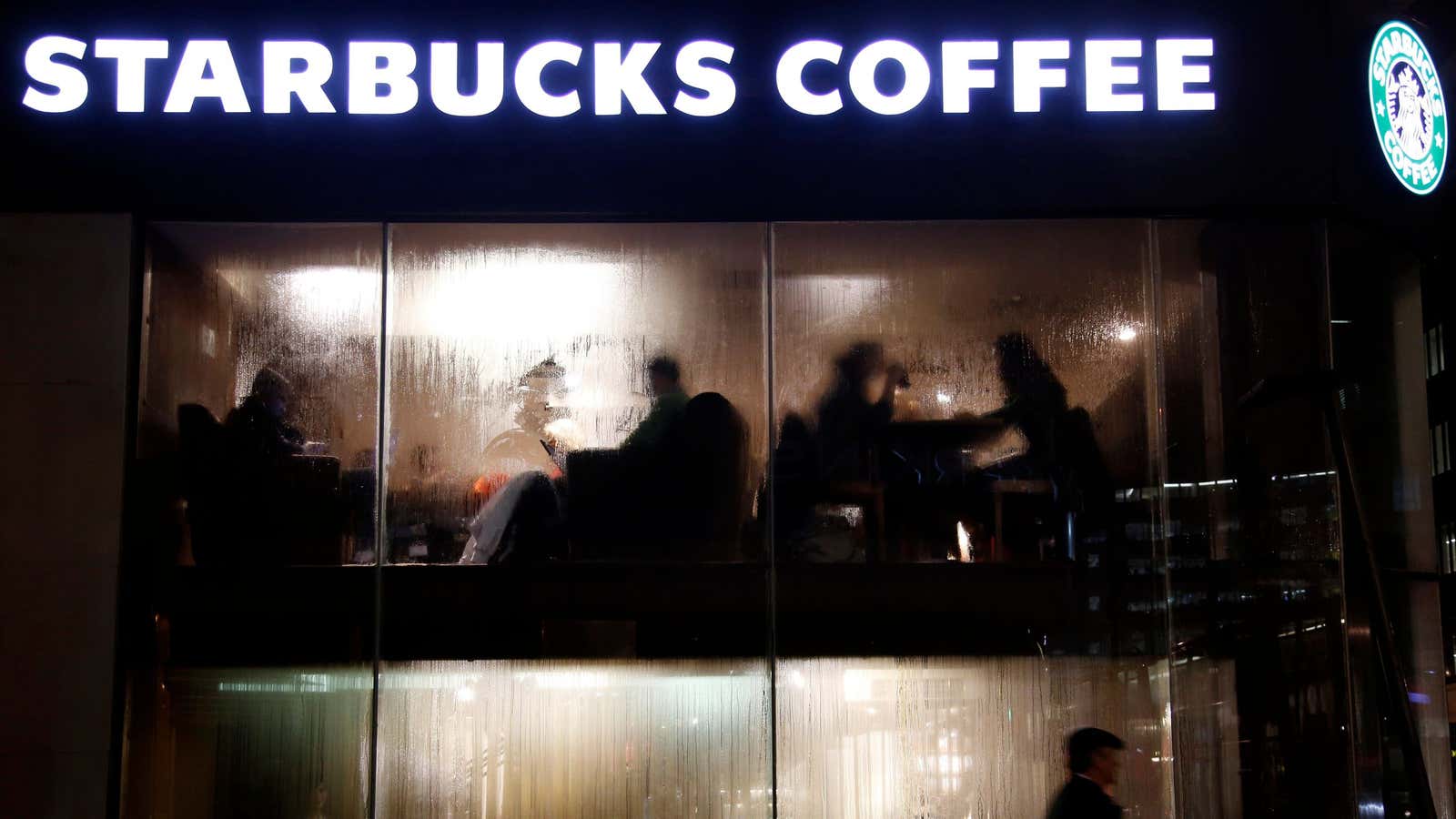In Austin Powers: The Spy Who Shagged Me, Dr. Evil’s team briefly abandons its traditional hostage-taking tactics and conspires to instead take over the world by investing in Starbucks.
Nineteen years later, it’s not quite so funny. Starbucks bills itself as “a third place between work and home.” It’s a private company that markets itself as a public space, marketing its coffee shops as venues where people can meet, relax, and work for hours on end. Starbucks has integrated itself into our lives, increasingly influencing how we gather in public. As two recent instances of racial discrimination show, though, it doesn’t offer its spaces to all equally.
The rise of coffee houses
The influence of coffee shops on society is not a modern phenomenon; the rise of coffee houses in 18th-century Britain has been credited with facilitating democratic discourse and the rise of a bourgeois class. But the coffee-shop landscape in earlier centuries was considerably different. By the first decade of the 1700s, there were 3,000 coffee houses in London alone, German philosopher Jürgen Habermas wrote in his 1962 book The Structural Transformation of the Public Sphere, but there was no single, giant, uniform coffee chain.
Men from the middle and upper classes went to these independent coffee houses to discuss literature and debate politics. Newspapers were passed around—two publications, Tatler and The Spectator, began as coffee-house periodicals—and coffee houses became the bedrock of the public sphere.
“The coffee house not merely made access to the relevant circles less formal and easier; it embraced the wider strata of the middle class, including craftsmen and shopkeepers,” wrote Habermas. Because of their diverse clientele and facilitation of political debate, coffee houses “were considered seedbeds of political unrest,” he wrote.
Today, Starbucks has built its business by co-opting this legacy. “Modern democratic debate began at the coffee house,” says Kazys Varnelis, historian of architecture and director of research nonprofit Netlab. “Starbucks, if anything, is trying to recapture that time.”
The rules for who could linger in a coffee house may not have been any less discriminatory in the 18th century than they are today—no women were allowed in these men’s only spaces—but they were certainly clearer. Varnelis explains that it wasn’t necessary to buy food or even coffee 200 or 300 years ago, but everyone had to pay an entrance fee: one penny. “They were called ‘penny universities’ because of the idea they were alternative educational structures,” he says.
It isn’t clear how everyone came to agree on the one-penny admission fee, but it was transparently and widely known. The rules on how Starbucks treats its customers, by contrast, are corporate and opaque, “It’s not one person, it’s an entity. We don’t know the rules,” says Varnelis. “It would be good if they did have some kind of clarity. I often wonder, what does it mean to use a toilet in a place where you don’t buy anything?” Starbucks hasn’t published clear rules on whether it allows people to use the toilet without buying anything or how long someone can stay after buying the cheapest coffee on the menu. In practice, Starbucks employees are often too busy to actually keep track of who buys is what, but as the latest videos show, store managers can take it upon themselves to kick people out.
How corporate ownership changes the coffee house
Starbucks is an international corporation and its cafes feel that way. There are none of the local quirks or communal conversations that there would have been in earlier coffee houses that served as the foundations of the public sphere. Nor can Starbucks truly be home to political debate and dissent, as coffee houses were in the 18th century. Whereas an individual cafe owner might be happy to allow boisterous political debates to hold forth on their venue, Starbucks store managers will always be thinking of their supervisors’ view, and inevitably trying to mute outlandish behavior. Holding a meeting of the socialist league at Starbucks “isn’t going to work out for anybody,” says Varnelis.
This may seem inconsequential to all but those planning immediate grassroots political movements, but public space is essential for community, quality of life, and democratic public discourse. “Is it uncomfortable that they pretend to be public or an extension of our homes when they aren’t. It appears to be public, it appears to be ours, and yet it isn’t. It’s a for-profit institution,” says Varnelis.
Starbucks’ mimicry of public space is successful in part because of the erosion of genuine public space. “There’s the expansion of places that appear to be public but really are private,” says Varnelis. Venues where people can gather in public are increasingly rare as governments allow private companies to manage parks and permit restaurants to spill onto the sidewalk, creating privately owned public spaces. People go to Starbucks to use the restroom because, quite simply, there’s nowhere else to go.
In some cases, the coffee chain has attempted to emulate its 18th-century predecessors’ role as sociocultural catalyst. In 2015, Starbucks launched a “Race Together” campaign, which encouraged customers to talk about race in America, but was disparaged as a facile response to a complex issue. It was one of many signs that the company cannot credibly take on the sort of public role that these sorts of initiatives suggest while operating as private corporation with opaque rules.
If Starbucks wants to function as a private company, it can demand that customers buy something whenever they enter. If it wants to be a public space, it should expect people to use the restroom and linger in the seats—and publicize clear rules around this sort of usage. Starbucks will never be a true public venue, as the chain will always have to please its corporate owners first. But, in claiming to be a “third place,” Starbucks turns a shallow imitation of public space into a privatized commodity that we have to pay to use.
